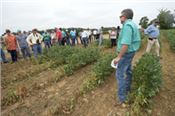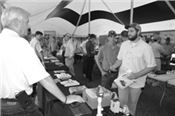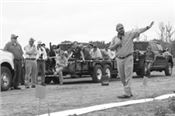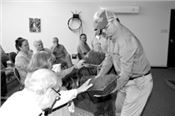|
AgCenter Field Day Expo Offers New Forum For Agriculture Information

LSU AgCenter weed scientist Donnie Miller, right, listens as attendees of a field day expo try to guess what kind of herbicide caused
the injury to the soybeans seen at left. The expo was held June 19, 2018, at the AgCenter Scott Research, Extension and Education Center in Winnsboro.
Photo by Olivia McClure/LSU AgCenter
WINNSBORO, LA.
The LSU AgCenter hosted its first-ever field day expo on June 19 in Winnsboro, expanding the concept of a traditional row crop field day to include information on horticulture programs, wildlife and other topics.
About 160 people came to the expo at the AgCenter Tom H. Scott Research, Extension and Education Center.
“One of our main goals of the event was to provide a variety of educational programs and bring as many of our clientele and stakeholders through the station as possible,” said Tara Smith, director of the central and northeast regions of the AgCenter.
They were able to see a broader picture of the work the AgCenter does to benefit Louisiana. In addition to the tours of crop research plots that are a hallmark of field days, attendees also had the chance to go to a horticulture seminar and visit more than 25 vendor booths.
AgCenter personnel joined those from the Louisiana Department of Agriculture and Forestry and the Natural Resources Conservation Service for a training session on pest management as part of the expo, too.
The expo replaces two previous annual field days: one that was held at the Northeast Research Station in St. Joseph, the other at the Dean Lee Research, Extension and Education Center in Alexandria. It will rotate among locations in the central and northeast regions each year.
Some researchers found ways to make their presentations more interactive for the new event.
At one stop on the field tour, weed scientists guided attendees through several soybean plots, each of which had been sprayed with one-tenth of the recommended amounts of different herbicides — simulating the kind of damage that can occur because of improper application and drift.
“Over the last couple of years, one of the bigger topics in respect to weed science has not been actually controlling the weed, but it’s been off-target movement of herbicides,” said AgCenter weed scientist Donnie Miller.
The scientists asked people to guess which chemical had caused various symptoms of herbicide injury. Some plants’ leaves were yellowed or cupped, while other plants were twisted or bent.
“We wanted to show people what we actually see in the field,” Miller said, so they can identify signs of herbicide-related problems themselves.
Rogers Leonard, AgCenter associate vice president, noted another new element of the event.
“We have more youth here,” he said, pointing out a group of students doing internships at the Scott center and a group of Louisiana FFA members who attended the expo.
The average age of the American farmer is 58 and continues to rise, Leonard said. He added that it’s important to encourage young people to explore agriculture and possible careers in the field.
Among the FFA members at the event was Caitlin McBride, an Area I officer of the organization and a West Ouachita High School student. She and four other officers came in hopes of drawing real-world connections to subjects they have learned about in FFA.
In the vendor booth area, they were able to meet people who work in agriculture, including some who sponsor and assist with FFA activities, McBride said.
“It just gives us a better idea of how all of these programs … work together,” she said.
Besides the weed science presentation, the field tour featured talks on plant diseases and insects, cotton and soybean planting considerations, and agriculture policy. The horticulture seminar covered native plants, the Louisiana Super Plants program, lawn weeds and tips on attracting birds to gardens.
Dr. Jim LaCour, the state wildlife veterinarian with the Louisiana Department of Wildlife and Fisheries, gave a keynote address on chronic wasting disease, which damages the nervous system and ultimately causes death in cervid animals such as deer.
The disease has not been found in Louisiana yet, but it was identified in January in Mississippi just across the Mississippi River from northeast Louisiana. It also has been observed in Texas and Arkansas, “so we’re surrounded,” LaCour said.
His department is closely monitoring deer populations for symptoms, which include being unable to walk and drooling, he said. A carcass importation ban also is in effect, limiting what kinds of deer carcasses can be brought into the state.
Chronic wasting disease is caused by a prion – a type of protein particle – that can be spread through saliva, feces and decomposing carcasses.
“It’s a very hardy infectious particle,” LaCour said. “Once you’ve got it, you’ve got it. Our goal is to keep it out of Louisiana.” ∆

More than 25 vendor booths were at the field day expo held June 19, 2018, at the AgCenter Scott Research, Extension and Education Center in Winnsboro.
Photo by Karol Osborne/LSU AgCenter

LSU AgCenter soybean specialist Todd Spivey speaks at a field day expo held June 19, 2018, at the AgCenter
Scott Research, Extension and Education Center in Winnsboro.
Photo by Olivia McClure/LSU AgCenter

LSU AgCenter weed scientist Ron Strahan, right, displays a container of grass during a gardening seminar at a
field day expo held June 19, 2018, at the AgCenter Scott Research, Extension and Education Center in Winnsboro.
Photo by Karol Osborne/LSU AgCenter
|
|